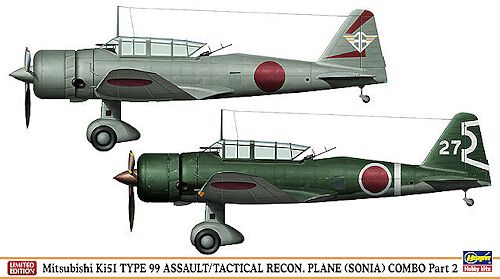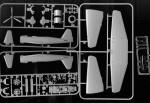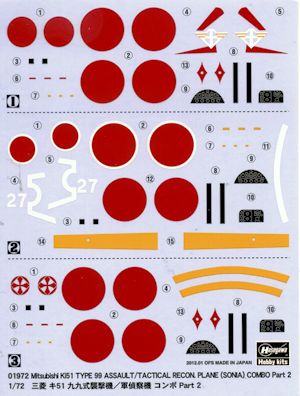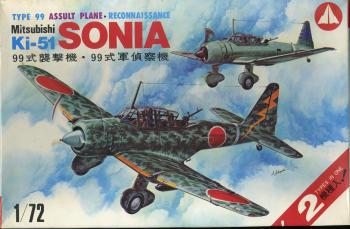
Hasegawa 1/72 Ki-51 'Sonia' Combo Part 2
| KIT #: | 01972 |
| PRICE: | $19.99 on sale ($45.00 SRP) |
| DECALS: | Three options |
| REVIEWER: | Scott Van Aken |
| NOTES: | 2012 Limited Edition. Two complete kits |

| HISTORY |
The Mitsubishi Ki-51 (Army designation "Type 99 Assault Plane". Allied nickname "Sonia") was a light bomber/dive bomber in service with the Imperial Japanese Army during World War II. It first flew in mid-1939. Initially deployed against Chinese forces, it proved to be too slow to hold up against the fighter aircraft of the other Allied powers. However, it performed a useful ground-attack role in the China-Burma-India theatre, notably from airfields too rough for many other aircraft. As the war drew to a close, they began to be used in kamikaze attacks. Total production was around 2,385 units.
Charles Lindbergh, flying a P-38 Lightning shot down a Ki-51 after a vigorous dogfight in which the much slower Ki-51 utilized its low speed maneuverability and made a fight of it. The Ki-51 served on all fronts in which the Japanese served. They were used right up to the end of the war. Those left in the Dutch East Indies were used by the nascent Indonesian Air Force and the Communist Chinese used them until about 1953.
| THE KIT |
 This
is one of several kits that were acquired by Hasegawa when they bought Mania
back in the early 1970s. The kit has engraved panel lines, a reasonably well
detailed cockpit that includes crew figures if you so wish, and a nicely done
though somewhat generic two row radial engine. The fixed gear have the wheel
molded into one spat half and the engine cowling is split vertically with a
separate front section. Bomb racks for the lower wings are provided as well as a
load of light bombs. About the only real option I could see is the ability to
cut out fuselage and lower wing window sections if one is doing the
reconnaissance version. In this case, the already drilled holes in the lower
wing will need to be filled as the recce birds didn't have bomb racks.
This
is one of several kits that were acquired by Hasegawa when they bought Mania
back in the early 1970s. The kit has engraved panel lines, a reasonably well
detailed cockpit that includes crew figures if you so wish, and a nicely done
though somewhat generic two row radial engine. The fixed gear have the wheel
molded into one spat half and the engine cowling is split vertically with a
separate front section. Bomb racks for the lower wings are provided as well as a
load of light bombs. About the only real option I could see is the ability to
cut out fuselage and lower wing window sections if one is doing the
reconnaissance version. In this case, the already drilled holes in the lower
wing will need to be filled as the recce birds didn't have bomb racks.

Instructions are typical Hasegawa and have Gunze paint references. Markings are provided for three planes. First up is an assault plane from the 67th Flight Regiment based at Hachinohe in 1943. This in is overall green grey. Next is a tactical recon version of the 52nd Independent Flight Company based in the Philippines during late 1944. It is green uppers with grey underside and with the yellow wing leading edge bands. The final option is another assault plane from the Hokota Flying School during 1942. It is also in overall green-grey. The decal sheet is very nicely done and provides instrument decals as well as the leading edge bands for the second option. Wing walk decals are also included. The decals are new school where the whites are actually white.
| CONCLUSIONS |
 Hasegawa
provided two full kits in this boxing, something that harkens back to my Mania
kit, which is #01 and also includes two full kits with six markings options. The
Mania kit was also only 800 yen in Japan (at the then exchange rate of 325 yen
to the dollar, that was less than $3.00) Comparing the sprues of the Mania kit
with the 2012 Hasegawa release, I noticed almost no difference in the quality of
the molds. Hasegawa has cut the sprues a bit to get them to fit into their
narrower standard box, but aside from that and a teeny bit of additional flash
(mostly on clear bits), they are the same. The sprue scan is of the Mania
boxing. It is an important aircraft that deserves to be on your shelves and now
you have the chance to do two of them at a most reasonable price if you can find
the kit on sale as did I.
Hasegawa
provided two full kits in this boxing, something that harkens back to my Mania
kit, which is #01 and also includes two full kits with six markings options. The
Mania kit was also only 800 yen in Japan (at the then exchange rate of 325 yen
to the dollar, that was less than $3.00) Comparing the sprues of the Mania kit
with the 2012 Hasegawa release, I noticed almost no difference in the quality of
the molds. Hasegawa has cut the sprues a bit to get them to fit into their
narrower standard box, but aside from that and a teeny bit of additional flash
(mostly on clear bits), they are the same. The sprue scan is of the Mania
boxing. It is an important aircraft that deserves to be on your shelves and now
you have the chance to do two of them at a most reasonable price if you can find
the kit on sale as did I.
| REFERENCES |
http://en.wikipedia.org/wiki/Ki-51
February 2014 If you would like your product reviewed fairly and
fairly quickly, please
contact
the editor or see other details in the
Note to
Contributors.